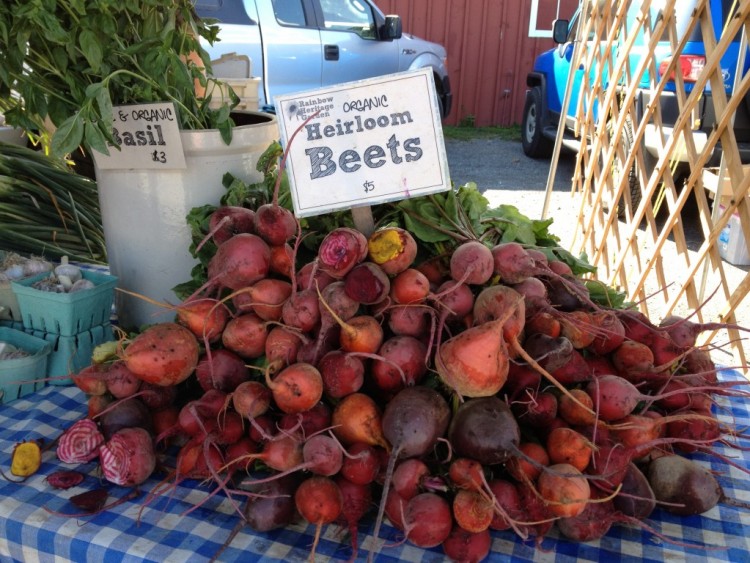I love burgers. In fact, I had a great burger last week at one of my favorite burger joints in Ottawa – Hintonburger. Seriously. If you live in Ottawa and haven’t had ‘The Hintonburger’ make it a priority.
Apart from the superior taste and their brand new digs on Wellington St, one of the best things is that Hintonburger buys their beef from a farm located exactly 56.1km from their kitchen. Not only that but these cows are of the pasture raised, drug-free variety.
Contrast that with the absolutely mind-blowing distance your average burger or steak travels in Southern Ontario: 5,770 km.
And if you’re thinking – “Aha! Those damned meat eaters and their earth-killing food miles…” Those pears and apples you eat every day? They travel more than 6,000 km.
Sadly those are not outliers in the marketplace.
Data from a 2005 study from the Waterloo (ON) Region Public Health Department looked at the ‘food miles’ for 58 commonly imported foods and uncovered that the average distance traveled was 4,497 km!
Importantly, they were careful to only include products (fruit, veg, dairy, meat & poultry) that could easily be produced locally.
Here’s a sample of some of the most common foods:
beef 5,770
pears 6,054
lettuce 3,726
tomatoes 2,800
potatoes 2,832
peppers 3,281
apples 5,925
onions 3,570
cheese 5,278
carrots 3,936
When it comes to ‘Food Miles’ the argument you are probably used to hearing is the environmental and economic impacts (both for & against) of increasing food miles.
The Benefits Of Buying Local Produce
Since I’m not an environmentalist nor an economist, I’m going to focus on what I think is the biggest long term cost of consuming “fresh” food transported 1000’s of miles from your plate: food quality – the actual nutrient density of the food on your plate.
The argument starts with a pretty logical premise: Fresh is best. While there are a few exceptions to this (fermented foods come to mind), this general principle is hard to argue particularly as it applies to fresh vegetables and fruit.
It just happens that this premise has been repeatedly tested and supported by good quality scientific research. The quality and quantity of nutrients in vegetables, fruits and animal products is highest at the time of cultivation.
The issue is really two-fold:
1. The length of time from cultivation to consumption has a direct impact on the nutrient density of foods.
Take spinach for example: Spinach has many nutrient benefits, a big one being its high B-vitamin content. So when this Penn State study demonstrated that spinach lost 47% of its folate (B9) content in just 8 days, that got my attention.
2. In order to increase their shelf-life, fruits and vegetables are cultivated in their unripened form.
Food starts to change as soon as it’s harvested and its nutrient content begins to deteriorate. as an example, total vitamin C content of red peppers, tomatoes, apricots, peaches, and papayas has been shown to be less than 50% when picked unripe compared when these crops are picked ripe.
Obviously the effect of these principles depends on the specific fruit or vegetable in question, but generally the greater the food miles, the greater impact it has on nutrient density, and thus on food quality.
If you’ve attended our Eat By Design Seminar, you know that nutrient density is a BIG DEAL.
After all, that’s the whole purpose of eating right? To fulfill our requirements for fuel – macronutrients like fat, protein, and carbohydrate, and micronutrients like essential vitamins and minerals. The best way to do that is to focus on consuming foods with the highest nutrient density and the least amount of toxicity.
So what’s the best option for maximizing nutrient density and minimizing toxicity?
At this time of year, the answer is a no-brainer: Shop at your local farmer’s market and seek out the organic producers, of which there are many.
Does organic trump local produce?
What about in the middle of winter when there’s virtually no local organic options? Is it better to buy organic from California or non-organic from your neighborhood farmer?
I address that exact question in part 2 of this series where I dive into my own personal process for deciding when to prioritize local over organic and vice versa.
Curious about what Eat By Design is all about? Check out the Eat By Design Quick Start Guide!
 Dr. John MacPhee is a Chiropractor, speaker and passionate health and wellness expert. He has inspired thousands of people to take control of their own health using the Life By Design method. Dr. John is co-owner of The Wellness Group, the largest Life By Design Certified Chiropractic office in Canada. Apart from full time practice, John maintains a busy speaking schedule, with a particular emphasis on improving productivity and focus at work. Otherwise you can find John training hard at CrossFit 613, exploring Gatineau Park, or holed away studying the latest research at various cafes across the west end.
Dr. John MacPhee is a Chiropractor, speaker and passionate health and wellness expert. He has inspired thousands of people to take control of their own health using the Life By Design method. Dr. John is co-owner of The Wellness Group, the largest Life By Design Certified Chiropractic office in Canada. Apart from full time practice, John maintains a busy speaking schedule, with a particular emphasis on improving productivity and focus at work. Otherwise you can find John training hard at CrossFit 613, exploring Gatineau Park, or holed away studying the latest research at various cafes across the west end.

[…] conventional greenhouse spinach from Quebec? Well, remember that Penn State article I mentioned in last week’s post? For spinach and other greens, the reduction in nutrient quality was the same whether the product […]